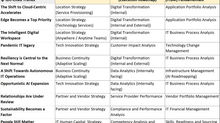- Michael Cross
Why a Chief Digital Officer?

When companies understand the need to transform their business through a digital lens, they often understand the basics to define a strategy, rationalize funding, and identify the impacts of falling behind in an age where consumers are attached to their phones. But when it comes to organizational alignment there are a variety of views on how to approach this, and often a company will grapple with the idea of having a single digital leader or a CDO (Chief Digital Officer).
While there isn't a precise right answer to the ultimate question, there are plenty of wrong answers that can cause companies to churn time, money, and even further disappoint their customers. Although certain industries continuously transform, most traditional industries have not, and the executives who lead these companies are the ones who need to make these key organizational design decisions. As with many leadership challenges, we use a balance of criteria including evaluating existing leaders, incremental costs for new programs, business impacts, etc. And even though this balance makes sense and has helped us be successful, the mindset for transforming your business requires innovation and calculated risks.
Answer Is....X (think Family Feud)
Here is the quick summary for digital transformation approaches that are either poor or a signal
that you aren't really "all in".
Divide it Up
Yes, a digital transformation always requires an entire organization to shift- objectives, investments, culture- it ALL changes. However, that doesn't mean you divide up the leadership for your digital movement. So while you need marketing to scan the value proposition, define and live the brand, lead key campaigns..and you need IT to integrate new platforms and technologies....and you need operations to put traditional processes aside and innovate around the customer...please don't divide up the leadership for this transformation. People butt heads, committees/meetings equal zero movement, and you'll likely be tapping into talent that has not actually led this type of work.
Hire a Firm
I am the first to leverage consulting arms where it makes sense. And I'd even recommend leveraging a consultant to advise on this specific topic or for accelerating the actual work. However, once you've decided that your company needs to transform, you don't want to send a message to your organization that this is interim, temporary, or a quick fix.
Incremental
This is a pitfall that has many different meanings. You add digital to the strategy or the road map, but don't address anything organizationally. Maybe you form a committee or add a line item to the budget, but you don't do anything organizationally. Another example of incremental that isn't necessarily a bad move is to start a COE (Center of Excellence) or an incubator team to innovate. This could be a good first step, but you will still need a master plan to take the bigger step towards transformation.
Just Add Some New Technology
Take it to the cloud, start calling things agile or DevOps, retire a few old systems, add tools and then more tools....apologies for the thick sarcasm. Although some of these executed in harmony and with intent can be part of the recipe of success, these will often build even more technical debt and overhead. The technology and tools must enable the experiences you are trying to fulfill. And ultimately, you will need people, technology, and processes that support rapid prototyping, continuous improvement, and proactive change.
The Answer
The answer is more about the principle of leveraging a primary single leader over this type of transformation. Title isn't crucial. Reporting relationship is tricky. If reporting to the CEO, then people quickly think that is too much power or the position is more of a figurehead. If they report into marketing, HR, or technology, then they are viewed in the traditional manner for that applicable organization. But if we can align on the premise of a successful transformation, then you can start seeing why having a single leader is so crucial.
The premise for a successful transformation is that you will deliver amazing digital experiences to your customers and employees, and you will do it in an accelerated fashion, though innovative methodologies, which will also require new technologies and services. You will not only deliver against business goals, you will drive costs out of your organization. That means you need a strategist, business leader, tech leader, and on top of all of that, someone who understands innovation and the roles required to actually deliver. And these roles are not the traditional ones- digital product management, software designers (and there are many different micro-roles within design), software engineers, cloud engineers, and strategists who are innovative.
If you align on the general premise, and you also know that you need to move fast, then a digital-savvy and experienced leader is welcomed for most any organization. And to be honest, this isn't the type of role someone is comfortable with unless they have either done it or played complementary roles within a digital organization.
The person must be action oriented, see the value in delivering product to the market to learn, and then have the people, processes, and analytics to turn on a dime. I always say- why do we have the indicator to perform app updates on our phone on a daily basis...because that is a digital team making a software update and reacting to customer needs.
Michael Cross is a Digital expert and executive, leading strategy, DevSecOps, and customer innovation in various sectors. https://www.linkedin.com/in/mtcdigital/





















